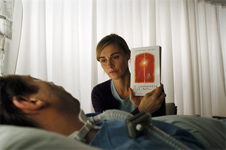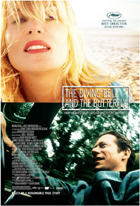The Diving Bell and the Butterly (Le Scaphandre et le papillon)
|  The cinema is a medium of movement. Even in the earliest days of fixed-camera actualities, when complex narrative was as fantastical an idea as a lengthy tracking shot, audiences were fascinating by movement in the frame; in other words, they don’t called them “movies” for nothing. Thus, you can imagine the difficulty involved in even conceptualizing how to bring to the screen the story of Jean-Dominique Bauby, the editor of the European fashion magazine Elle who had a massive stroke at age 43 and found himself imprisoned within his own body. A victim of “locked-in syndrome,” he was fully cognizant, but could move no part of his body save his left eye. If ever there was an inherently un-cinematic subject, this is it. The cinema is a medium of movement. Even in the earliest days of fixed-camera actualities, when complex narrative was as fantastical an idea as a lengthy tracking shot, audiences were fascinating by movement in the frame; in other words, they don’t called them “movies” for nothing. Thus, you can imagine the difficulty involved in even conceptualizing how to bring to the screen the story of Jean-Dominique Bauby, the editor of the European fashion magazine Elle who had a massive stroke at age 43 and found himself imprisoned within his own body. A victim of “locked-in syndrome,” he was fully cognizant, but could move no part of his body save his left eye. If ever there was an inherently un-cinematic subject, this is it.Yet, American painter-turned-director Julian Schnabel has done something very close to miraculous in making Bauby’s predicament fundamentally cinematic. Working with cinematographer Janusz Kaminski (a frequent collaborator of Steven Spielberg’s), Schnabel dares to root his film in the subjective, a tricky endeavor that risks slipping into gimmickry. For the first quarter of the film we are confined entirely to Bauby’s perspective, watching people move in and out of a slightly blurry, vaguely surreal, but always fixed frame of reference. We hear Bauby’s thoughts in voice-over, and we experience with him the shock of realization that the voice he thinks he’s speaking with exists only inside his own mind. Such an approach has its limits, and Schnabel eventually discards his complete reliance on first-person perspective for a varied approach that mixes subjectivity with a more traditional third-person view. We see Bauby (Mathieu Amalric), once a casually hedonistic bon vivant who had just left his wife for his mistress, now confined to a bed, his mouth distorted by gravity and one eye sewn shut to prevent it from further atrophy (one of the film’s biggest gambles is showing us the surgery from Bauby’s point of view, a scene that is simultaneously gross and utterly fascinating). Henriette (Marie-Josée Croze), his dedicated speech therapist, works out a system of communication in which she recites the alphabet in order of letters most frequently used and Bauby blinks when she hits the right one. It’s a long process that requires infinite patience, but it’s the only means Bauby has of communicating, and it is how he dictated the 1997 book on which Ronald Harwood’s screenplay is based. As in his two previous films, both of which are about artists (1996’s Basquiat and 2000’s Before Night Falls), Schnabel clearly wants to invest a great deal of the film in exploring Bauby’s means of creation, and in many ways that is primarily what The Diving Bell and the Butterfly is about (the title is drawn from Bauby’s metaphoric assessment of his being entrapped in his own body, much like being trapped inside a diving suit underwater, and his desire to break free and spread his imaginative wings). Bauby’s turning point is when he realizes that two important things were not paralyzed along with his body--his memories and his imagination--and Schnabel endeavors to bring to life Bauby’s mind by using lyrical stock footage of everything from a glacier breaking off into the ocean, to bullfighting, to images of a young Marlon Brando hamming it up in front of the camera. This focus has its own beauty, although it comes at the expense of other possibilities. Entranced as he is with Bauby’s unique predicament, Schnabel largely eschews the man himself, conveying him in fragmented flashbacks of high-end fashion shoots, weekends in a convertible with his lover, and taking care of his aging father (Max Von Sydow). We get the edges, but never the center. Bauby remains something of an abstraction, defined primarily by his internal monologue, which remains delightfully sharp and humorous even in the worst of times (when Henrietta is appalled by a pair of telephone installers making fun of his condition, he chides her inside his own mind for not having a sense of humor). At other times, thought, he comes across as decidedly cruel, such as when he has his devoted wife (Emmanuelle Seigner) translate for him on a phone call from his lover, who has not had the strength to come see him in his paralyzed condition. Thus, at the end of The Diving Bell and the Butterfly, we may have some sense of what Bauby endured, but not the much of the man himself. Schnabel invests so much of his energy and artistry to giving us a you-are-there view of being locked inside one’s physical body that he never quite conveys when it all meant to Bauby. The film is certainly rich in imagery, and its immersion into the subjective is a daringly successful conceit, but it never quite pulls all the pieces together. It remains, in a sense, as smudgy as its opening images. Copyright ©2008 James Kendrick Thoughts? E-mail James Kendrick All images copyright ©2007 Miramax Films |
Overall Rating: 

 (3)
(3)


